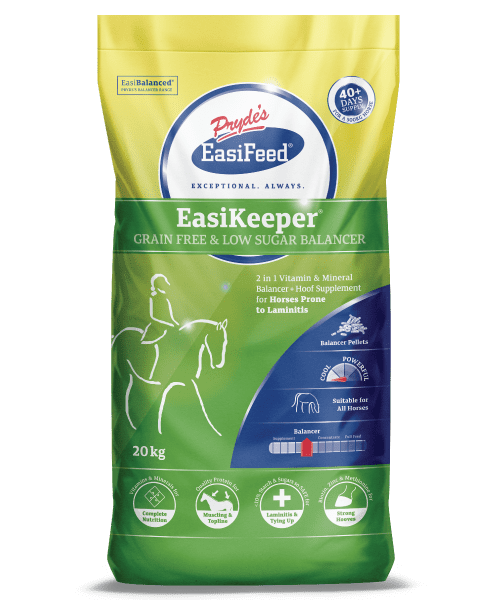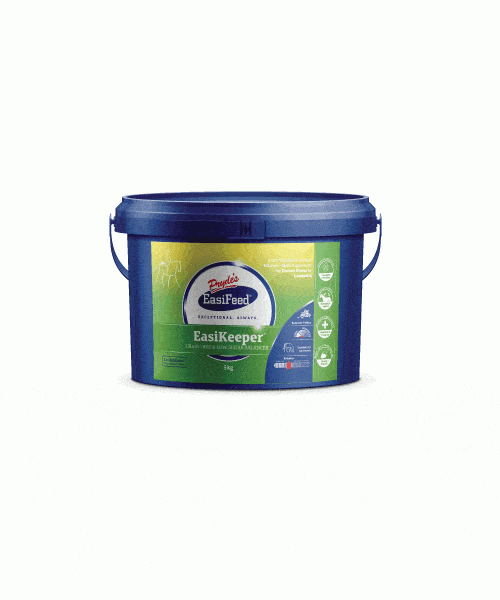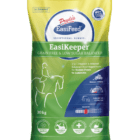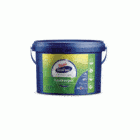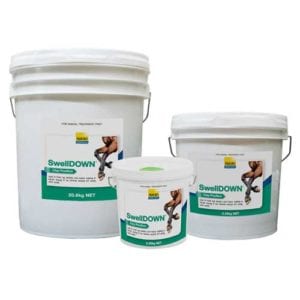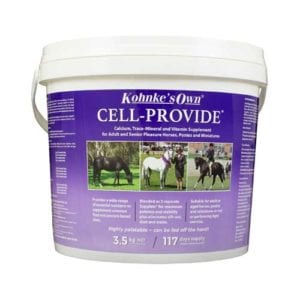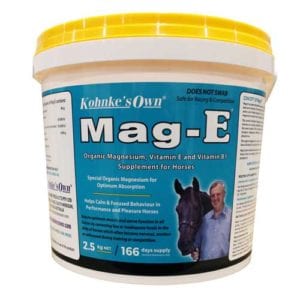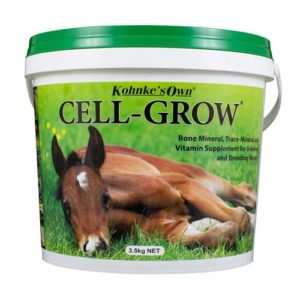Nutritional Analysis
Nutrition Information
Major Nutrients
Digestible Energy 10.6MJ
Crude Protein 18.0%
Crude Fibre 27.5%
Oil4.2%
Salt 1.0%
Essential Amino Acids
Lysine 10.3g
Methionine 6.2g
Threonine 6.8g
Sugars and Starch
Ethanol Soluble Carbohydrate (ESC)6.0%
Water Soluble Carbohydrate (WSC)6.7%
Starch 1.1%
Non-structural Carbohydrate (NSC)7.8%
Macro Minerals
Calcium 28.2g
Phosphorous 16.5g
Sodium 4.3g
Chloride 8.7g
Magnesium 10.4g
Potassium 8.8g
Trace Minerals
Copper 307mg
Zinc 925mg
Selenium 3.3mg
Manganese 349mg
Iodine 6.5mg
Iron*192mg
Cobalt 1.5mg
Chromium 10.0mg
Vitamins
Vitamin A 69500IU
Vitamin E 3500IU
Vitamin D 7200IU
Vitamin K 35.1mg
Vitamin B1 (Thiamine)91.8mg
Vitamin B2 (Riboflavin)73.6mg
Vitamin B3 (Niacin)235mg
Vitamin B5 (Pantothenic Acid)93.8mg
Vitamin B6 (Pyridoxine)23.7mg
Folic Acid 21.9mg
Biotin 40.6mg
Vitamin B12 211µg
* The iron present is naturally occuring in the ingredients used. EasiKeeper contains no added iron.
Feeding Rates
| |
Grams/100kg of Bodyweight per day |
EXAMPLE: amount/day for a 500kg horse |
| Horses & Ponies on Calorie Restricted Diets |
100 |
500g |
| Laminitis Recovery |
100 |
500g |
| Spelling Horses |
75 |
375g |
| Light Exercise |
80 |
400g |
| Moderate Exercise |
90 |
450g |
| Intense Exercise |
100 |
500g |
| Pregnant & Lactating Mares |
100 |
500g |
| Breeding Stallions |
100 |
500g |
| Weanlings, Yearlings & 2YO’s** |
100 |
500g |
**Use your horse’s expected mature bodyweight to calculate the correct dose. For example a weanling that will mature at 500 kg should receive 5 x 200 g = 1000 g/day.
Light Exercise: Up to 60 mins walking, or 30 mins walking, trotting and cantering.
Moderate Exercise: Up to 120 mins walking and trotting, or 30-60 mins trotting, cantering and some galloping.
Intense Exercise: 30-60 mins intense skill work, short duration galloping, racing and endurance.
For the Best Results
-
Introduce into a horse’s ration gradually over 2 weeks.
-
Feed in conjunction with appropriate low starch, low sugar forage (pasture, hay and/or chaff).
-
Make clean, fresh water and salt available at all times.
-
Adjust the amount fed so it is appropriate for a horse’s current activity and bodyweight.
-
Divide feeds into two or more smaller meals if feeding more than 0.5 kg per 100 kg of bodyweight in ‘hard feed’ per day.
-
The feeding rates given here are based on the amount of balancer pellet needed to meet a horse’s vitamin and mineral requirements. If you feed below these feeding rates, vitamin and mineral deficiencies will appear in the diet and may affect health and limit growth and sound development, reproduction, performance or recovery. It is best to feed this balancer pellet at the recommended amounts.
-
If you are feeding this balancer pellet in conjunction with one of the Pryde’s EasiFeed range of complete feeds the amount fed may be reduced. See the ‘Keep It Balanced’ information on the back of your feed bag for adjusted feeding rates.
Did You Know?
Most cases of laminitis are due to insulin resistance. The key to reducing the risk of laminitis is to keep blood glucose and insulin levels as low as possible. This is achieved by feeding grain free, low sugar, low starch diets.







